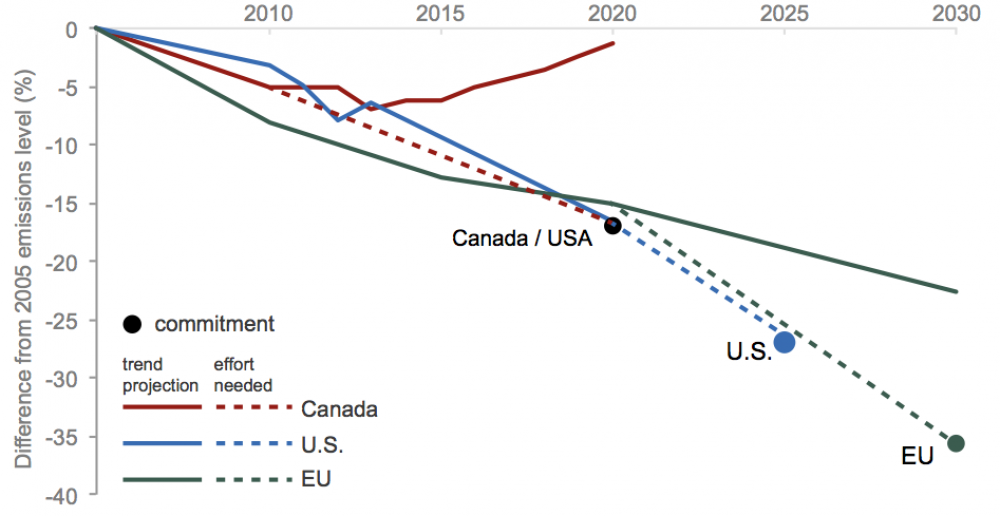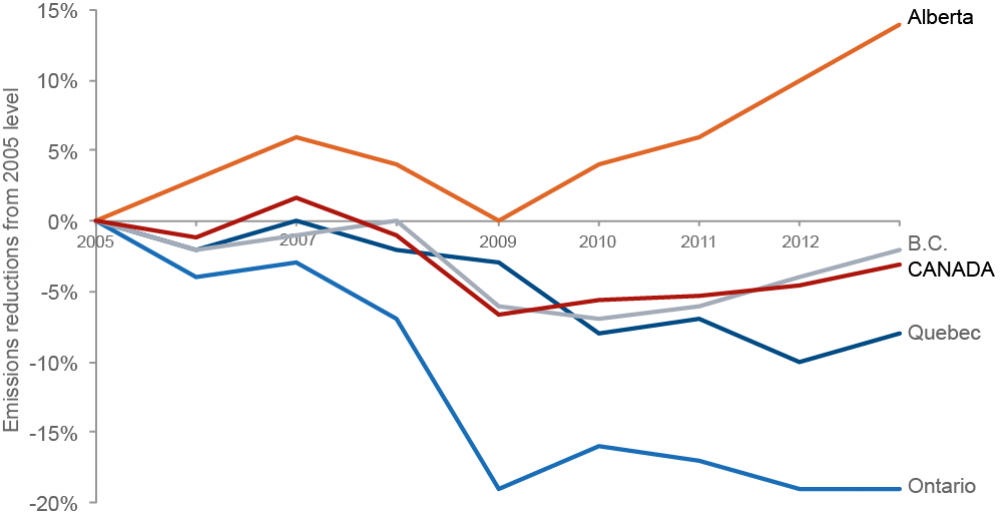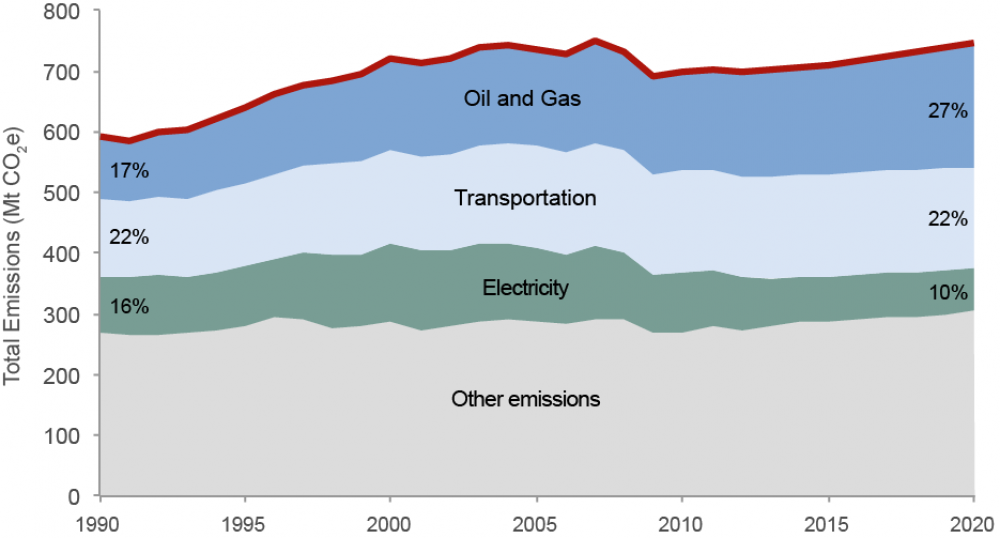Just as accountants like to celebrate a new fiscal year, climate scientists indulge in closing the books on national greenhouse gas inventories.
Canada’s emissions inventory is submitted annually to the United Nation’s Framework Convention on Climate Change (UNFCCC). The inventory covers the amount and types of emissions, as well as which sectors of the economy they come from. Because there is so much data, each assessment takes two years to compile.
The latest numbers confirm yet again that Canada is nowhere near meeting its emissions target of 17 per cent below 2005 levels by 2020. By contrast, the EU and U.S. are projected to meet or exceed their commitments and both are proposing more stringent targets beyond 2020. In Canada some provinces are slowly filling the leadership void left by federal government — leading with new measures and recognizing the need for economy-wide carbon pricing. Still, growth in oilsands emissions is undoing progress in the electricity and transportation sectors. More ambition is necessary as Canada’s failure to curb carbon emissions will be obvious at the upcoming Paris climate talks.
The new emissions inventory submission is different from previous years in a couple of ways. The UNFCCC has made changes to its accounting methods, meaning that — in addition to new numbers for 2013 — all previously reported numbers have been updated. The new method reflects improved reporting guidance from the Intergovernmental Panel on Climate Change. Also, updated assumptions about how much each type of greenhouse gas contributes to global warming means previously reported numbers needed to be bumped up.
In previous years — 2013 and 2014 — the Pembina Institute has explored three key stories, which we’ll revisit here with the new inventory numbers.
Story #1: Canada’s emissions trends
The new data shows Canada remains far off track, and suggests that each year that passes without more effective emissions limits will only make its commitment harder to meet.
Environment Canada's 2020 projection includes a change in land-use practices. This inventory bucket covers the addition or removal of emissions due to changing land areas, such as converting forest into agricultural land. The chart below does not include the credit.
Canada released 726 megatonnes (Mt) of greenhouse gas emissions in 2013. Environment Canada’s Emissions Trends 2014 report shows that, instead of going down, our overall emissions are rising as the 2020 deadline approaches. Without additional measures, Canada will only have reduced its emissions by 1.5 per cent below 2005 levels — a far cry from its 17-per-cent-reduction target.
Canada’s major economic partners have also set emissions reduction commitments for beyond 2020 that they are on track to achieve. If Canada is to be respected on the international stage, it must act now to curb emissions and align itself with its partners. Not taking action now will only widen the growing gap.
The chart shows the U.S. planning to meet its 17 per cent emissions reduction commitment by 2020. The White House has further committed to 26-28 per cent reductions by 2025, while Europe’s climate program now reaches to 2030.

The U.S. and EU targets are not just lip service. Both have submitted Intended Nationally Determined Contributions to global emissions reduction to the UNFCCC. Canada failed to meet its March 2015 submission deadline.
Story #2: Provinces that act also perform
In the absence of federal action, provinces have assumed climate leadership. Province-specific trends show jurisdictions acting on emission reduction goals are performing well, although the level of ambition reflected in provincial emissions-reduction targets varies significantly. Ontario’s 2013 emissions are 19 per cent below 2005 levels, Quebec’s are 8.4 per cent below, and B.C. is 2.5 per cent below.

Ontario has shown leadership in reducing emissions by phasing out coal-fired power generation and creating incentives for renewable energy generation through feed-in tariffs. B.C.’s carbon tax is a successful approach to cutting carbon emissions while growing the economy, as the province’s GDP modestly outperforms the rest of the country. Quebec — which benefits from abundant low-emissions hydropower — also took an early leadership role in 2013 by introducing Canada’s first carbon cap and trade program.
Ontario’s greenhouse gas emissions reduction target for 2020 is 150 Mt. Current measures will leave the province 20 Mt short of its goal. Permit trading within closes part of the gap and by partnering with the WCI the province hopes to further reduce the outstanding balance. Moreover, it intends to recycle some of the revenue toward its transportation sector — its fastest growing source of emissions.
And neither province is stopping there. The B.C. government has promised to release a follow-up Climate Action Plan 2.0 while continuing to draw praise from the international community for the design and implementation of its carbon tax.
Ontario has just announced its own carbon cap-and-trade program. It caps the amount of greenhouse gas emissions and introduces an auction mechanism for carbon emission permits — effectively placing a price on carbon. In the near future, the province hopes to link up its market with California and Quebec as part of the Western Climate Initiative (WCI). A bigger market for carbon permits increases the cost-efficiency of Ontario’s carbon reduction activities.
Story #3: Oilsands emissions are increasing while performance has stalled
Alberta’s climate policy — the Specified Gas Emitters Regulation (SGER) — targets just 12 per cent of emissions and only from large industrial sources. Because the policy doesn’t cover total emissions, the effective carbon price is only around $1.80 per tonne. SGER — which has been in place since 2007 — has not been effective.
The scale and pace of oilsands development is cause for concern as indicated in Canada’s 2014 national emissions trends report. Emissions from oil and gas production have surpassed the transportation sector and now accounts for 25 per cent of the national inventory. While the amount of greenhouse gas emissions per barrel of oil sands crude has decreased 28 per cent since 1990, nearly all the gains were made before 2005. Since then, emissions intensity has flat-lined while production is up 224 per cent. Forecasts pinpoint a further 187-per-cent increase by 2020 based on 2014 trends. All of this results in absolute emission increases from the oilsands sector. Further, the slice of emissions from oilsands production will likely keep growing in 2013 and beyond, having gone from 7.5 per cent in 2011, to 8.5 per cent in 2013.
The chart below illustrates the growth of emissions from Canada’s oil and gas sector as a share of total emissions from 1990 to 2020. Environment Canada projections illustrate a further increase by 2020. The dark red line on top captures all emissions excluding any credit from improved land-use practice in agriculture. The numbers show the reduction in emissions from electricity generation is offset by an increase from oil and gas.

Alberta says it’s committed to reaching its 2020 commitment at which point emissions would have to peak and then decrease. Achieving these reductions would require making up for lost time with a vastly improved plan — similar to those in B.C., Ontario and Quebec. But revising Alberta’s climate strategy will have to wait till after the provincial election.
The need for national leadership
Canada’s Ecofiscal Commission has published a report highlighting the effectiveness of carbon pricing in reducing emissions — encouraging innovation and supporting economic growth. Unlike the current sector-by-sector regulatory approach, an economy-wide carbon price sends a consistent signal as to what kinds of activity we do and don’t want.
A national, economy-wide price on carbon is essential if Canada is to have any hope of meeting its emissions reduction target. It’s an important international commitment in light of successful action taken by the U.S. and the EU. The coordination of provincial measures ensures the success of some jurisdictions is not negated by the growth of emissions elsewhere — particularly Alberta’s oilsands.
Provincial leaders that came together at the Quebec Climate Summit earlier this month recognized the scientific consensus on climate change and the effectiveness of pricing carbon across all sectors of the economy. As Canada prepares for international climate talks this December in Paris, it needs to embrace the fact that carbon pricing is an approach that — simply put — works.







